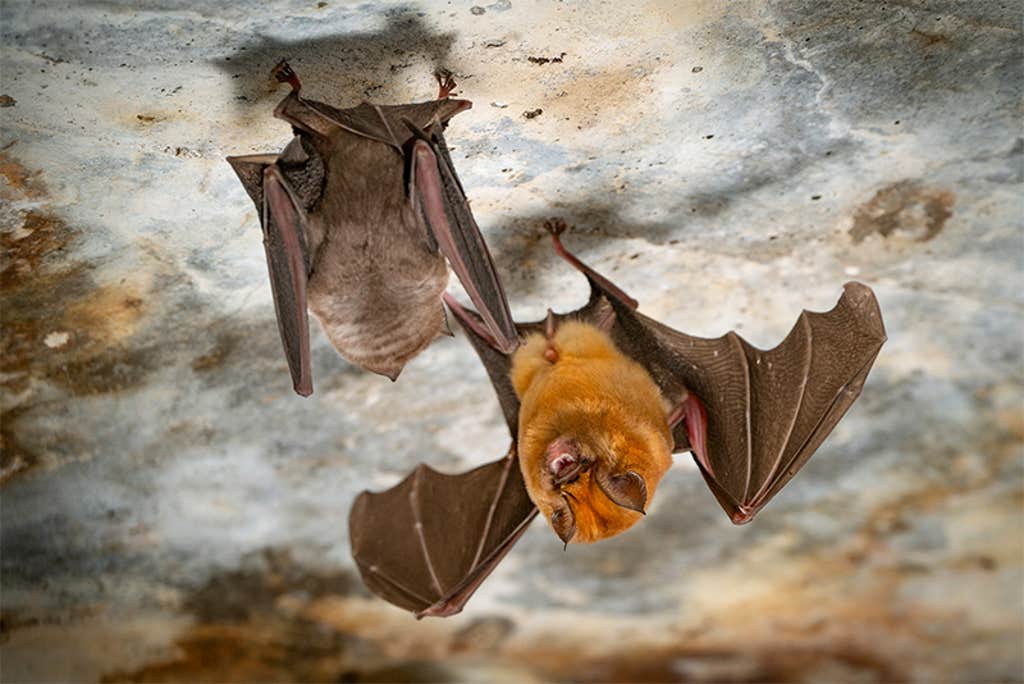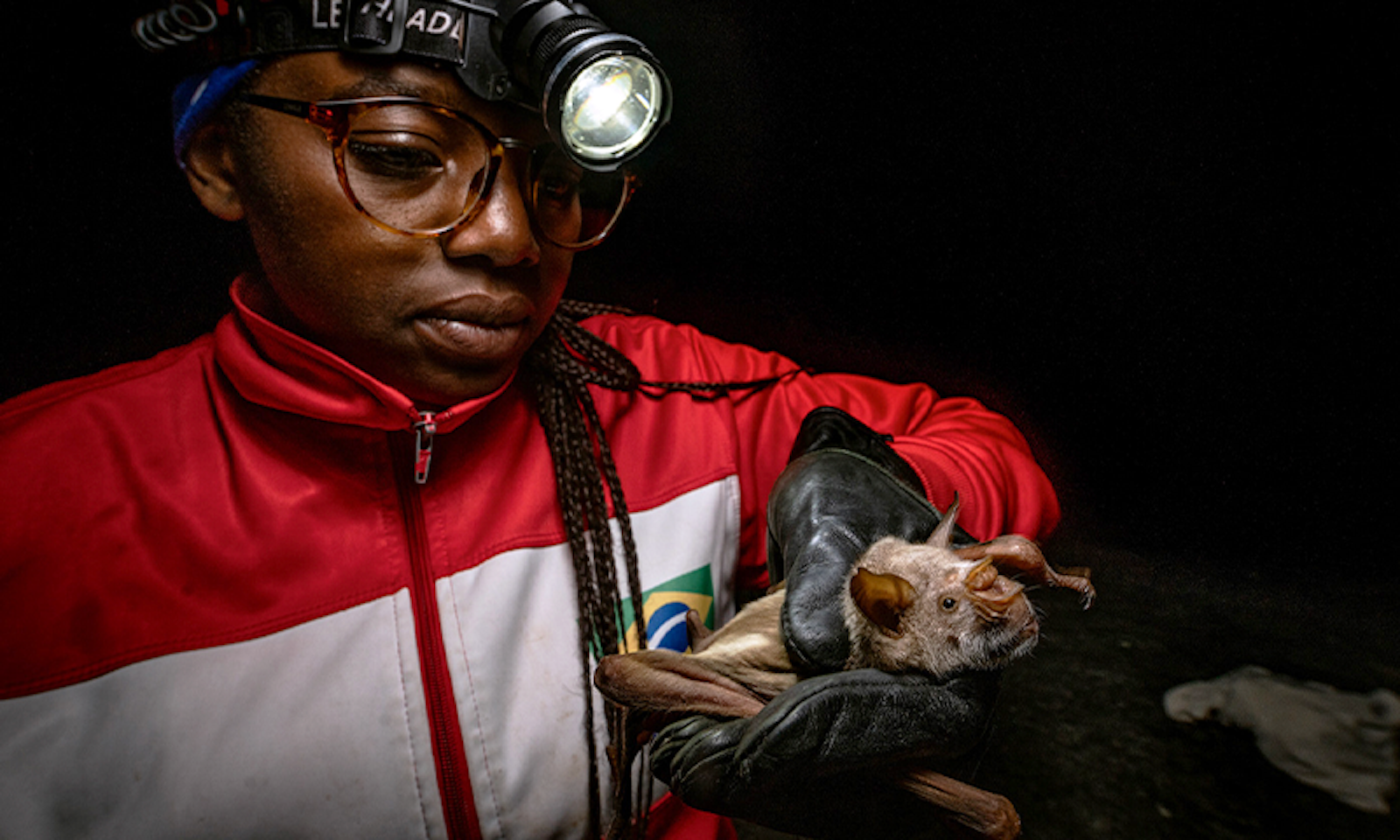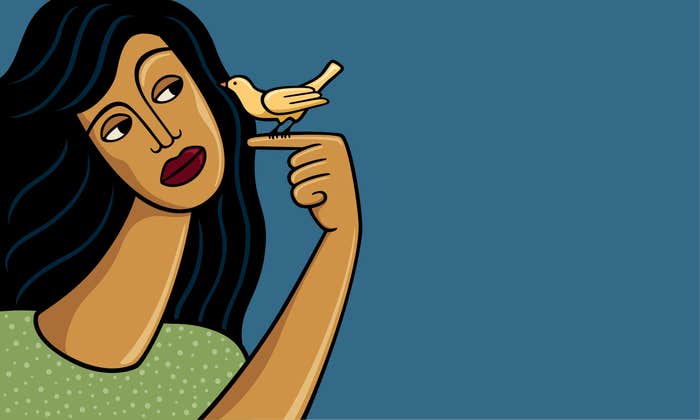
The squat abandoned concrete structure may have been a water tower when this tract of land in the grasslands of Mozambique was a cotton factory. Now it served an entirely different purpose: Housing a bat colony.
To climb through the building’s low opening, bat researcher Césaria Huó and I had to battle a swarm of biting tsetse flies and clear away a layer of leaves and vines. My eyes quickly adjusted to the low light, but my nose, even behind a mask, couldn’t adjust to the smell of hundreds of bats and layers of bat guano—a fetid reek of urea with fishy, spicy overtones. But Huó had a different reaction. “I don’t mind the smell now,” she said. After several months of monitoring bat colonies in the Gorongosa National Park area as a master’s student in the park’s conservation biology program, Huó said she almost likes it. “Now, when I smell it, I know there are bats here.”
Since we arrived at the tower during the daylight hours, I had expected the nocturnal mammals to be asleep. Instead, they were shaking their wings, flying from one wall or spot on the ceiling to another, swooping sometimes a bit too close to me for my comfort. But the bats didn’t care about me; they were cruising for mates. It was mating season, and we had lucked out to see their mating performances. Huó pointed out that some females were inspecting the males, checking out their wing flapping prowess.
Huó would set up devices to record the bat all night and hope it would call out.
But Huó and her adviser, the polymath entomologist Piotr Naskrecki, did not bring me to this colony to view the bats’ seductive dances and their feats of flight, since those behaviors are already known to scientists. We were here to decipher what the bats were saying while doing them. Huó and Naskrecki had set up cameras and audio recorders the night before to learn more about these bats and try to understand the nature of the calls they use, listening for signs of meaning.
Scientists have studied echolocation calls in some bat populations for decades. Echolocation is a kind of sixth sense that allows bats to use reflected sounds to fly blind and hunt in the dark, a superpower that has inspired aspects of human technologies such as sonar and new forms of radar. But we know much less about their social communication, said Naskrecki, who first became interested in the flying mammals while studying the ways some katydids adapted their morphology to avoid being captured by bats. He realized that bats are similar to primates in their behavior, and came up with a hypothesis.

“One thing that is interesting about primates is that they have developed this ability to warn other members of their group of different dangers and they have different expressions of different signals to indicate what type of danger that is,” Naskrecki said. “So, if it’s a snake, that will be one signal, if it’s a leopard, that’s another signal. I thought, well, I bet you that bats do the same thing. It’s just incredibly difficult to show it.”
Difficult because bats are skittish, often live in inaccessible areas, and many species are mostly active at night. Further, the calls they emit—echolocation or social—are at frequencies too high for the weak human ear to hear. “Every now and then you will hear a squeak,” Naskrecki said. “That squeak is like a roar to them.”
Naskrecki’s instinct about social communication in bats coincided with the ongoing research of Mirjam Knörnschild, an expert in the field and a professor of evolutionary ethology at Humboldt University Berlin. Naskrecki asked her to join Huó’s committee and she was glad to do so. “We have over 1,400 different bat species, and we only have vocal information—not complete information, but at least some information on their social communication calls or songs—for less than 100 species,” Knörnschild said.
I expected the nocturnal mammals to be asleep. Instead, they were swooping a bit too close for comfort.
Bats are one of the largest and most diverse groups of mammals. There are bats the size of a bumblebee and bats that weigh around the same as a small rabbit. Most bats live in colonies and many of them have incredibly complex social lives for which good communication is necessary. Scientists believe many species can sing; some can recognize each other’s voices; they have dialects; they can alert others to dangers; and they form intense bonds with their young.
“We know that mothers use a specialized tone of voice when they communicate with their pups, like motherese, what we humans do when we’re cooing at a baby, using this high pitch,” Knörnschild said. And there’s still so much to discover. Bats are an ancient group with many phylogenetically distinct species. “They could have come up with different solutions for the same problem,” Knörnschild said.
Once Huó and Naskrecki retrieve the audio and video recordings from the bat tower, they feed them to the computer, using a program to transform what sounds to humans like silence into the hum and buzz of hundreds of bats, a cacophony of sounds. “We slow it down, then we look at the spectrogram that shows us the pattern of these calls,” Naskrecki said. After screening out echolocation calls, which have already been collected in a database, they look for new patterns, cross-checking the video to see what the bats were doing when they made this or that sound. Naskrecki and Huó are trying to build a kind of dictionary of the calls of the bats who live in the abandoned tower—Hipposideros caffer aka Sundevall’s leaf-nosed bats—as well as those of the Egyptian whispering bat, Nycteris thebaica, who live in a semi-hollow tree in the sand forest inside the Gorongosa boundaries.

A few days after our excursion to the bat colony, Naskrecki showed me how he manipulated the squiggly waveforms on a large screen in his office until the clicks and hisses started to sound like chirping birds. One call of four staccato chirps stood out. “This is just a lonely male calling,” Naskrecki said. To correlate the call to the action, and infer its meaning, Naskrecki and Huó also conduct experiments in the lab by bringing bats from the colony into a controlled environment, to see if they make the same calls.
That morning they had brought back a tiny male bat that could fit in the palm of a human hand. It was afternoon and Huó was trying to tempt it to eat fresh meal worms and moths in a room across the hall from Naskrecki’s office. But the little guy was refusing. Maybe the room was too loud or too bright. Maybe it was stressed out by the big human (a monster to the bat, no doubt) who was trying to feed it mysterious foods. Huó was worried because this wasn’t the first bat they had captured, but at least the eighth, and two of them had gotten so stressed out that they’d died. After feeding it, she planned to release it into the bat room, a small room with walls painted black and a fake tree or two, as well as a cozy fake cave to help the bat get comfortable. Huó would set up devices to record him all night and hope it would call out—perhaps a kind of distress call—so she could add the call to the dictionary.
Distress calls are one of the most universal bat social calls, said neuroethologist Angie Salles, who runs a lab studying social communication in bats at the University of Illinois, Chicago. “If you play back the distress calls, you usually attract bats to the area where you’re playing those back, and it doesn’t necessarily attract only that species of bat,” she said.
Salles conducts similar experiments at her bat lab, but with slightly different goals. She uses captive colonies and sometimes attaches little electrodes to their heads to measure variations in their brain activity depending on their behavior or when they are exposed to different sounds. She’s especially interested in how bats interpret these auditory communications in different contexts. “Let’s say a bat is engaged in a fight with another bat,” she said. “Maybe a distress call will have a more salient response than if the bat is doing something else.” She hopes to gather ideas about how brains (the bats’ but also human, yours and mine) process the sounds that become language.
The morning after I watched Huó try to feed the bat, I went back to the lab to check on it. Huó said it was doing fine. “He’s eating OK and I saw him hunting last night,” she said. It had hunted some of the crickets and moths she had thoughtfully planted in its room. We found it resting upside down (naturally) on a branch. In the room there was another recorder, poised to capture its sounds and songs, and if the bat lived through this ordeal, he would go back to his colony in a day or two.
Naskrecki said his goal is to create a captive colony in the bat room and compare it to roosting spots in the wild. (They don’t plan to maintain a permanent captive colony of bats—only to keep and grow one for the duration of Huó’s master’s project.) The researchers will then have a listening post to hear what bats say when they are content, sending out messages of social cohesion; when there’s a threat and they want to attack or flee; or when they woo their sweethearts or coo to their young. Inaudible to humans, the lab will be alive with the sound of bat talk for scholars to decipher and interpret. ![]()
Jori Lewis writes narrative nonfiction that explores how people interact with their environments. Her reports and essays have been published in The Atlantic, Orion, and Emergence Magazine, among others. She is a senior editor of Adi Magazine, a literary magazine of global politics. In 2022, she published her first book, Slaves for Peanuts: A Story of Conquest, Liberation, and a Crop That Changed History, winner of a 2023 James Beard Media Award.
Lead photo: Césaria Huó, a master’s student in Gorongosa National Park’s conservation biology program, examines a bat.
The Nautilus Gorongosa Series is published in partnership with the Howard Hughes Medical Institute’s Science and Educational Media Group.




























